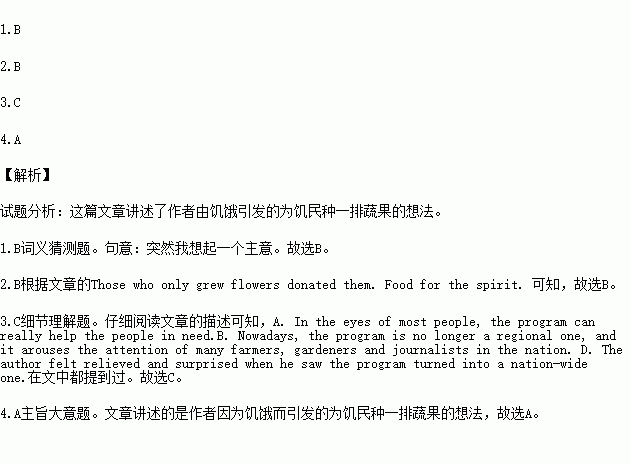题目内容
It was a cold night in Washington, D. C., and I was heading back to the hotel when a man approached me. He asked if l would give him some money so he could get something to eat. I'd read the signs "Don't give money to beggars." So I shook my head and kept walking.
I wasn't prepared for a reply, but he said, "I really am homeless and I really am hungry! You can come with me and watch me eat!" But I kept on walking.
The incident bothered me for the rest of the week. I had money in my pocket and it wouldn't have killed me to hand over a buck or two even if he had been lying. Flying back to Anchorage, I couldn't help thinking of him. I tried to rationalize (找借口)my failure to help by thinking government agencies, churches and charities were there to feed him. Besides, you're not supposed to give money to beggars.
Somewhere over Seattle, I started to write my weekly garden column for The Anchorage Daily News. Out of the blue, I came up with an idea. Bean's Cafe, the soup kitchen in Anchorage, feeds hundreds of hungry Alaskans every day. Why not try to get all my readers to plant one row in their gardens dedicated to Bean's? Dedicate a row and take it down to Bean's. Clean and simple.
The idea began to take off. Readers would fax or call me when they got something in their garden. Those who only grew flowers donated them. Food for the spirit.
In 1995, the Garden Writers Association of America held their annual convention in Anchorage and after learning of Anchorage's program, Plant a Row for Bean's became Plant a Row for the Hungry. The original idea was to have every member of the Garden Writers Association of America write or talk about planting a row for the hungry sometime during the month of April.
As more and more people started working with the Plant a Row idea, new changes appeared unexpectedly. Many companies gave free seed to customers and displayed the logo, which also appeared in national gardening publications. Row markers with the Plant a Row logo were delivered to gardeners to set apart their "Row for the Hungry."
Garden editor Joan Jackson, supported by The San Jose Mercury News and California's nearly year-round growing season, raised more than 30,000 pounds of fruits and vegetables her first year, and showed GWAA how the program could really work. Texas fruit farms donated food to their local food bank after being inspired by Plant a Row. Today the program continues to thrive and grow.
I am surprised that millions of Americans are threatened by hunger. If every gardener in America--and we're seventy million strong--plants one row for the hungry, we can make quite a decrease in the number of neighbors who don't have enough to eat. Maybe then I will stop feeling guilty about abandoning a hungry man I could have helped.
1.What does the underlined phrase "out of the blue" mean?
A. a bit disappointed B. suddenly
C. as a matter of fact D. attentively
2.The program has been supported by many farmers, journalists and people in different fields for many years. They usually donate many things to it except______________ .
A. money B. flowers C. seeds D. beans
3.Which is WRONG according to the passage?
A. In the eyes of most people, the program can really help the people in need.
B. Nowadays, the program is no longer a regional one, and it arouses the attention of many farmers, gardeners and journalists in the nation.
C. It occurred to the author that they could run such a program the moment he gave the beggar nothing.
D. The author felt relieved and surprised when he saw the program turned into a nation-wide one.
4.Which do you think is the best title to the passages?
A. Plant a row for the hungry
B. How to help others
C. A story of a columnist
D. Not for fame and wealth
 习题精选系列答案
习题精选系列答案
